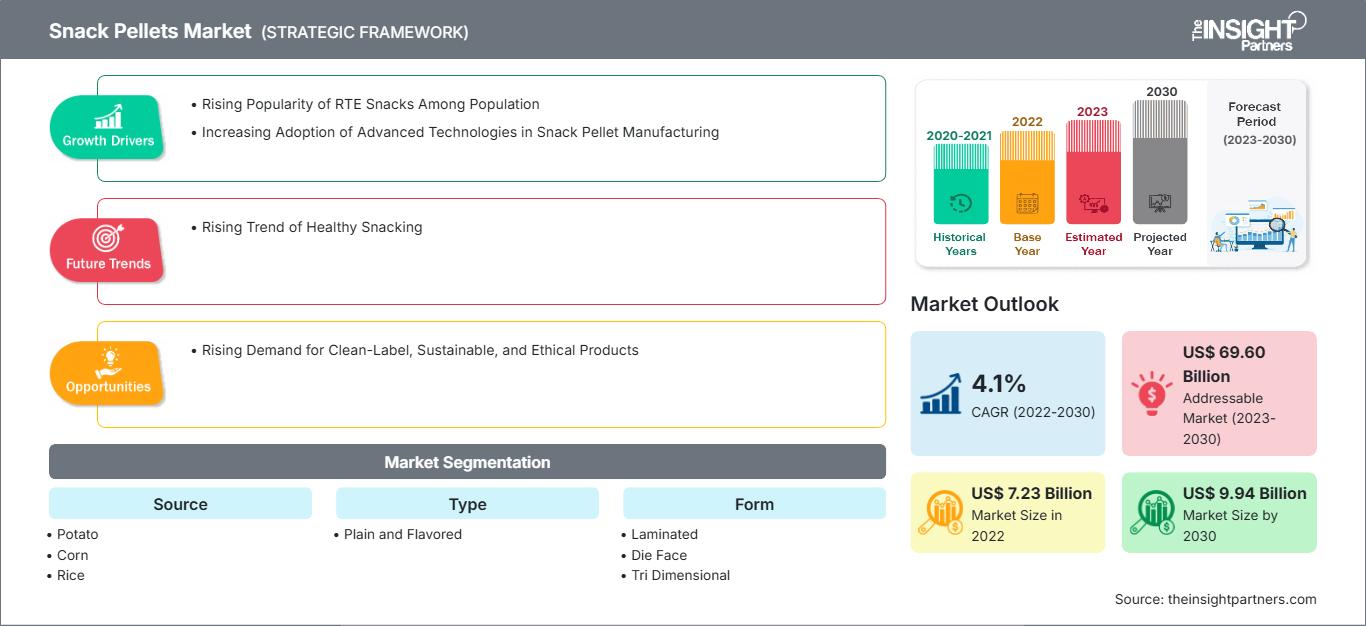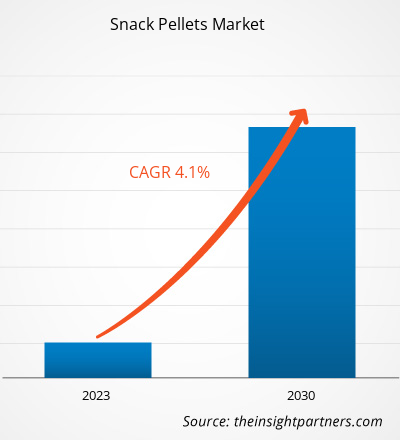[Rapporto di ricerca] Si prevede che il mercato degli snack pellet crescerà da 7.228,70 milioni di dollari nel 2022 a 9.935,20 milioni di dollari entro il 2030; si prevede che il mercato registrerà un CAGR del 4,1% dal 2022 al 2030.
Approfondimenti di mercato e punto di vista degli analisti:
Gli snack pellet sono prodotti non espansi realizzati con materie prime tra cui patate, mais, riso, tapioca, cereali integrali e altre. Questi pellet vengono essiccati e semilavorati per facilitarne lo stoccaggio e la spedizione. Questi prodotti semilavorati vengono venduti ai produttori di snack, dove vengono ulteriormente lavorati con vari metodi come la frittura e la cottura ad aria calda. La domanda di snack pellet è attribuita alla crescente domanda di prodotti alimentari pronti e alla crescente adozione di tecnologie avanzate nella produzione di snack pellet. Si prevede che la crescente domanda di pellet per snack ne guiderà la crescita del mercato.
Fattori di crescita e sfide:
Anche gli snack pronti al consumo (RTE) stanno registrando una domanda massiccia, soprattutto tra i professionisti, a causa della crescente tendenza a consumare snack nelle aziende. Piccole pause caffè e spuntini per alleviare lo stress lavorativo stimolano la domanda di snack RTE. Snack leggeri come popcorn, patatine e bignè sono popolari tra i giovani e i bambini. Pertanto, la crescente popolarità degli snack RTE tra i consumatori e le crescenti innovazioni guidano il mercato globale dei pellet per snack. Inoltre, la tecnologia di estrusione, un processo cruciale nella produzione di pellet per snack, si è evoluta, consentendo ai produttori di creare snack diversificati con qualità, consistenza e gusto migliorati. Questi progressi tecnologici hanno aumentato l'efficienza produttiva e facilitato la creazione di opzioni di snack innovative e accattivanti, soddisfacendo le mutevoli preferenze dei consumatori. Pertanto, l'introduzione di estrusori bivite, l'integrazione della stampa 3D e l'adozione di controlli intelligenti e automazione incrementano la produzione di una vasta gamma di pellet per snack, alimentandone la crescita del mercato globale. Tuttavia, le fluttuazioni dei prezzi delle materie prime chiave, come cereali e legumi, possono avere un impatto diretto sulla struttura dei costi dei produttori di pellet per snack. Poiché i pellet per snack dipendono in larga misura da queste materie prime, qualsiasi aumento sostanziale dei costi può comportare un aumento delle spese di produzione. Pertanto, l'aumento dei costi di produzione ostacola la crescita del mercato globale dei pellet per snack.
Personalizza questo rapporto in base alle tue esigenze
Potrai personalizzare gratuitamente qualsiasi rapporto, comprese parti di questo rapporto, o analisi a livello di paese, pacchetto dati Excel, oltre a usufruire di grandi offerte e sconti per start-up e università
Mercato dei pellet per snack: Approfondimenti strategici

-
Ottieni le principali tendenze chiave del mercato di questo rapporto.Questo campione GRATUITO includerà l'analisi dei dati, che vanno dalle tendenze di mercato alle stime e alle previsioni.
Segmentazione e ambito del rapporto:
Il "mercato globale degli snack pellet" è segmentato in base a origine, tipologia, forma e area geografica. In base all'origine, il mercato degli snack pellet è segmentato in patate, mais, riso, tapioca, multicereali e altri. In base alla tipologia, il mercato è suddiviso in aromatizzati e semplici. In termini di forma, il mercato degli snack pellet è segmentato in laminati, con superficie stampata, tridimensionali e altri. Il mercato in base all'area geografica è segmentato in Nord America (Stati Uniti, Canada e Messico), Europa (Germania, Francia, Italia, Regno Unito, Russia e resto d'Europa), Asia Pacifico (Australia, Cina, Giappone, India, Corea del Sud e resto dell'Asia Pacifico), Medio Oriente e Africa (Sudafrica, Arabia Saudita, Emirati Arabi Uniti e resto del Medio Oriente e Africa) e Sud e Africa. America Centrale (Brasile, Argentina e resto dell'America meridionale e centrale).
Analisi segmentale:
In base alla fonte, il mercato degli snack pellet è segmentato in patate, mais, riso, tapioca, multicereali e altri. Il segmento delle patate detiene una quota significativa del mercato. La domanda di snack pellet di patate è in forte aumento tra i produttori di snack grazie al loro diffuso appeal, al loro status di comfort food e alla costante domanda dei consumatori di snack a base di patate. Questi pellet possono essere fritti o cotti al forno per creare uno snack croccante e gustoso. I produttori richiedono snack pellet di patate poiché i consumatori li preferiscono per il loro sapore familiare, la consistenza e la versatilità di aromatizzazione. Si prevede che questi fattori aumenteranno la quota di mercato del segmento.
Analisi regionale:
In base alla geografia, il mercato degli snack pellet è suddiviso in cinque regioni chiave: Nord America, Europa, Asia-Pacifico, America meridionale e centrale e Medio Oriente e Africa. Il mercato globale degli snack pellet è stato dominato dall'Asia-Pacifico; il mercato in questa regione è stato valutato a 3.472 milioni di dollari nel 2022. Il Nord America è il secondo principale contributore al mercato, detenendo quasi il 25% del mercato globale. Si prevede che l'America Centrale e Meridionale registrerà un CAGR del 5,1% nel mercato degli snack pellet durante il periodo di previsione. La crescita del mercato degli snack pellet nella regione è attribuita alla crescente domanda di cibi pronti, alla crescente adozione di tecnologie avanzate nella produzione di snack pellet e al crescente sviluppo dell'industria di trasformazione alimentare in economie come Cina, India e Indonesia. Stili di vita sempre più frenetici, orari di lavoro prolungati e un numero crescente di famiglie con doppio reddito hanno contribuito alla crescita di alimenti confezionati come patatine e popcorn. Si prevede che questi fattori stimoleranno la domanda di snack pellet nell'Asia-Pacifico.
Inoltre, l'Europa è una delle regioni più significative per il mercato degli snack pellet. In Europa, gli snack pellet a base di patate sono ampiamente preferiti dai consumatori. Inoltre, si prevede che gli snack pellet a base di mais acquisiranno popolarità grazie all'introduzione di nuove ricette incentrate su ingredienti a base di mais. Il crescente consumo di cibi pronti e l'introduzione di nuovi snack aromatizzati sono i principali fattori che dovrebbero incrementare la domanda di snack pellet nella regione.
Sviluppi del settore e opportunità future:
Di seguito sono elencate le varie iniziative intraprese dai principali attori che operano nel mercato degli snack pellet:
- A settembre 2022, Pringles, un marchio di snack di Kellogg Company, ha lanciato patatine multicereali e di patate dolci con claim non HFSF (non ad alto contenuto di grassi, zuccheri e sale). Queste patatine sono fatte di grano, orzo, fagioli neri e patate dolci, ottime fonti di fibre, proteine e carboidrati buoni, e sono disponibili in gusti innovativi come Sale Marino, BBQ Affumicato, Ranch Casalingo e Cheddar di Fattoria.
- Nel giugno 2022, GEA Group ha sviluppato un nuovo formato di snack chiamato "Cinderella's Slippers", uno snack a forma di pantofola. Il nuovo formato è stato sviluppato per affrontare la sfida di immergere gli snack nella salsa senza sporcare le dita.
- Nel 2022, LENG-D'OR SAU, un produttore di snack a forma di pantofola con sede in Spagna, ha annunciato l'espansione della capacità produttiva in Spagna e negli Stati Uniti, raggiungendo oltre 338,95 milioni di dollari all'anno.
Impatto del COVID-19:
La pandemia di COVID-19 ha colpito quasi tutti i settori in diversi paesi. Lockdown, restrizioni di viaggio e chiusure aziendali nel Nord America, Europa, Asia-Pacifico (APAC), America Meridionale e Centrale (SAM) e Medio Oriente e Africa (MEA) hanno ostacolato la crescita di diversi settori, tra cui quello alimentare e delle bevande. La chiusura delle unità produttive ha interrotto le catene di approvvigionamento globali, le attività produttive, i tempi di consegna e le vendite di prodotti essenziali e non essenziali. Diverse aziende hanno registrato ritardi nelle consegne e un crollo delle vendite nel 2020, con un impatto negativo sul mercato degli snack in pellet.
Durante la pandemia di COVID-19, operazioni e processi sono stati interrotti in tutto il mondo a causa della carenza di manodopera e della limitata fornitura di materie prime. Tuttavia, sulla scia della pandemia, la domanda di snack salutari è aumentata in modo significativo, poiché i consumatori si sono concentrati sulla propria salute e sul benessere generale. Pertanto, i produttori si sono concentrati sul lancio di nuovi prodotti con diverse indicazioni nutrizionali, come biologico, senza glutine, ad alto contenuto proteico, senza soia, senza organismi geneticamente modificati (OGM) e senza allergeni. L'aumento di questa tendenza durante la pandemia ha influenzato positivamente il mercato degli snack in pellet. mercato.
Nel 2021, diverse economie hanno ripreso le attività poiché diversi governi hanno annunciato un allentamento delle restrizioni precedentemente imposte, con un impatto positivo sul mercato globale. Inoltre, ai produttori è stato consentito di operare a piena capacità, il che li ha aiutati a colmare il divario tra domanda e offerta.
Approfondimenti regionali sul mercato dei pellet per snack
Le tendenze regionali e i fattori che influenzano il mercato degli snack pellet durante il periodo di previsione sono stati ampiamente spiegati dagli analisti di The Insight Partners. Questa sezione illustra anche i segmenti e la geografia del mercato degli snack pellet in Nord America, Europa, Asia-Pacifico, Medio Oriente e Africa, America Meridionale e Centrale.
Ambito del rapporto di mercato dei pellet per snack
| Attributo del rapporto | Dettagli |
|---|---|
| Dimensioni del mercato in 2022 | US$ 7.23 Billion |
| Dimensioni del mercato per 2030 | US$ 9.94 Billion |
| CAGR globale (2022 - 2030) | 4.1% |
| Dati storici | 2020-2021 |
| Periodo di previsione | 2023-2030 |
| Segmenti coperti |
By Fonte
|
| Regioni e paesi coperti |
Nord America
|
| Leader di mercato e profili aziendali chiave |
|
Densità degli operatori del mercato degli snack pellet: comprendere il suo impatto sulle dinamiche aziendali
Il mercato degli snack pellet è in rapida crescita, trainato dalla crescente domanda da parte degli utenti finali, dovuta a fattori quali l'evoluzione delle preferenze dei consumatori, i progressi tecnologici e una maggiore consapevolezza dei benefici del prodotto. Con l'aumento della domanda, le aziende stanno ampliando la propria offerta, innovando per soddisfare le esigenze dei consumatori e sfruttando le tendenze emergenti, alimentando ulteriormente la crescita del mercato.

- Ottieni il Mercato dei pellet per snack Panoramica dei principali attori chiave
Panorama competitivo e aziende chiave:
Alcuni dei principali attori che operano nel mercato globale degli snack pellet sono Bach Snacks SAL, Snack Creations Ltd, Balance Foods Inc, LENG-D'OR SAU, Quality Pellets AS, JR Short Milling Co, Le Caselle SpA, Mafin SRL, Noble Agro Food Products Pvt Ltd e Société Cooperative Agricole Limagrain. Questi attori del mercato adottano iniziative di sviluppo strategico per espandersi, stimolando ulteriormente la crescita del mercato degli snack pellet.
- Analisi storica (2 anni), anno base, previsione (7 anni) con CAGR
- Analisi PEST e SWOT
- Valore/volume delle dimensioni del mercato - Globale, Regionale, Nazionale
- Industria e panorama competitivo
- Set di dati Excel
Report recenti
Testimonianze
Motivo dell'acquisto
- Processo decisionale informato
- Comprensione delle dinamiche di mercato
- Analisi competitiva
- Analisi dei clienti
- Previsioni di mercato
- Mitigazione del rischio
- Pianificazione strategica
- Giustificazione degli investimenti
- Identificazione dei mercati emergenti
- Miglioramento delle strategie di marketing
- Aumento dell'efficienza operativa
- Allineamento alle tendenze normative






















 Ottieni un campione gratuito per - Mercato dei pellet per snack
Ottieni un campione gratuito per - Mercato dei pellet per snack